The legend of the Four Sons Aymon
"Etalle, land of springs and of Four Aymon Sons"

It is in these terms that the municipality of Etalle is often presented.
Indeed, various sites of the forest of Etalle-Virton correspond to episodes of the famous medieval legend:
What about the history
The "Epic Song of the Four Aymon Sons" is a story created from scratch by the troubadours who went from castle to castle and fair to fair singing short stories. The first stories certainly originated in the North of France, in the Ardennes, since everything seems to indicate that the 4 Aymon sons were from this country. But the founders were travelers and the story was each time declined to adapt to the region where it was told. There are even manuscripts from Venice, and other regions, German or English.
It was probably created at the beginning of the second millennium and transcribed in medieval literature from the 13th century. This legendary story is for the Frankish and Celtic race what the adventures of Achilles, Ulysses, Menelaus, Agamemnon, Priam, Hector, Patroclus,… were for the Greeks. It is the Iliad of the Middle Ages.
It is a pure legend because, historically, the sons of Duke Aymon would have lived under the reign of King Charles Martel, that is to say a century before Charlemagne. In addition, in the legend, Renaud's adventures continue in Judea, Palestine, Jerusalem, while the time of the Crusades comes only two centuries after the reign of Charlemagne. And then the emperor appears as a ridiculous, disloyal, cowardly man who never has good ideas, spends his life getting stupidly angry, falls into mad states of exasperation as soon as he is upset. br> We never see him dealing with schools, the administration of his kingdom, diplomatic relations, ...
It was Charles V (king of France from 1364 to 1380), the first, who wanted to include the story of the Four Aymon Sons among the books of what would later become the "national library". He therefore did make a "translation" into good French of the poem of the Four Sons Aymon, of which there were an infinite number of varieties, especially because he liked the spirit of the valiant knights which is told in this story: their qualities of nobility, righteousness, simplicity, sincerity, courage ... He therefore gave the text its final and official authenticity. This was a handwritten version which was printed later, in 1480. It is on the basis of this incunabula that history was transmitted through the centuries that followed.
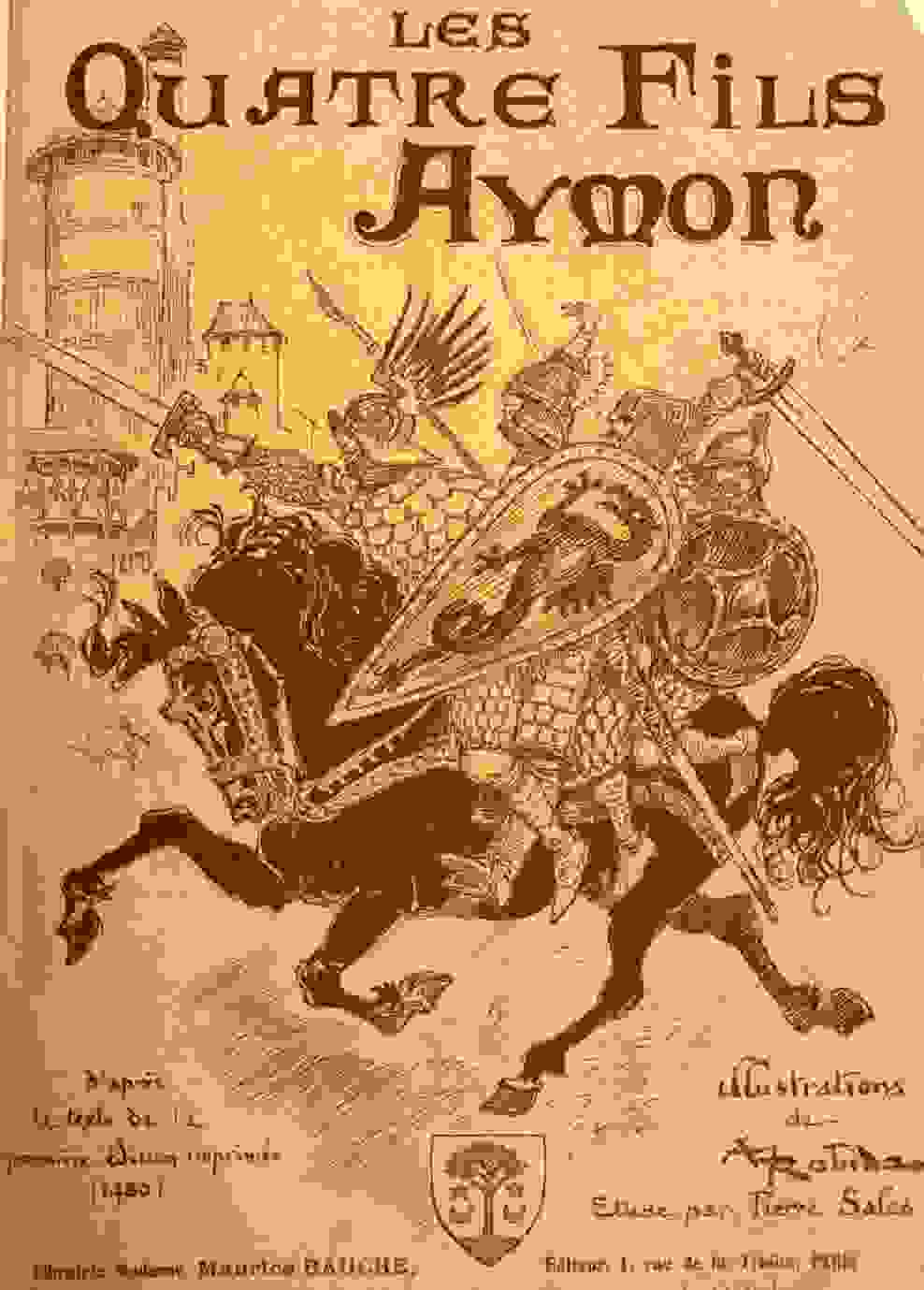
There are dozens of versions of copies of the story, in various forms, including on the internet.
There are also excellent studies on the matter, accompanied by in-depth analyzes of the relationship with historical facts.
This website does not at all pretend to add its own interpretation and, to briefly recall the history of these valiant knights, it will be based on a book from 1908 which, according to Jean d'Albignac, its author, is based on wants a fairly accurate transcription of the manuscript printed in 1480.
But which remains however a free text translation of the original poem written in verse and in Old French.
The tale is broken down into 28 chapters, the first few of which will be summarized here in a few tables.
History of the Four Aymon Sons, very noble and very valiant knights

One day of Pentecost, Charlemagne holds a great and solemn celebration in Paris where he notably invites the valiant Duke Aymon de Dordonne and his four sons: Renaud, Allard, Guichard and Richard.
They are beautiful and powerful, especially Renaud.
During this feast, Charlemagne explains to his hosts that he lost many knights during his battles and that he had not always been helped by his vassals, including the Duke of Aigremont, brother of Duke Aymon.
To tell him that he was dissatisfied and that if he did not come to assist him in his battles, he would besiege Aigremont and destroy all his land, he sent his son Lohier as a messenger, accompanied by 100 knights.
However, the Duke of Aigremont refuses to help Charlemagne and kills Lohier and all his troop, with the help of his son Maugis, who is also an enchanter.

Meanwhile, Charlemagne worries about not seeing Lohier return.
Duke Aymon then suggests sending his 4 sons to Aigremont. Charlemagne accepts and names them knights.
Renaud is the most valiant and he rides the horse Bayard, which he had received precisely a little earlier from his cousin Maugis.
But an emissary arrives at Charlemagne's palace and announces the death of his son.
Charlemagne is very saddened and angry by this news.
As it is his own brother who committed this murder, Duke Aymon prefers to return home to Dordonne, accompanied by his 4 sons.
Charlemagne is very irritated and swears that the four Aymon sons would pay dearly for it.
After terrible battles between Charlemagne's troops and those of the Duke of Aigremont, the latter finally bowed before the king, who forgave him.
But Count Ganelon, angry at the death of his cousin Lohier, gathers an army, besieges Aigremont and kills the duke.
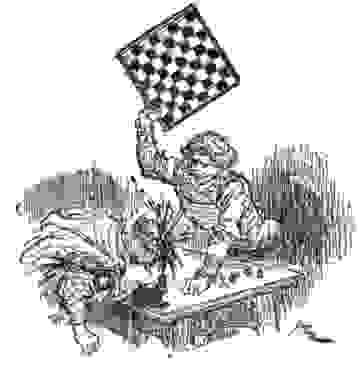
At Pentecost the following year, Charlemagne still had a feast, which was still attended by the Duke Aymon de Dordonne accompanied by his 4 sons.
Renaud is angry with Charlemagne whom he considers responsible for the death of his uncle.
However, the atmosphere of the party relaxes and Berthelot, the king's nephew, offers Renaud a game of chess.
During the game, the two men quarrel and Renaud grabs the solid gold chessboard and fatally strikes Berthelot on the head.
Charlemagne had Renaud pursued, but he managed to escape with his brothers and his cousin Maugis who had helped them to escape.

Charlemagne's men pursue them, but fail to injure them.
Renaud and Maugis, riding Bayard as well as Allard, Guichard and Richard, on their horses, arrive in Dordonne.
The mother of the 4 brothers is very angry that Renaud killed Berthelot.
They therefore leave the city every 5 to enter the great Ardennes forest via the Vallée aux Fées.
They ride as long as they find themselves on the banks of the Meuse.
They notice a suitable place where they build a castle by the river.
They call this castle Montfort (or Montessor, depending on the translations).
The father of 4 brothers promises the king to punish his children.

Seven years later, Charlemagne learns that the 5 young people are in the castle of Monfort.
He gathers an army, with several barons of France, including Duke Aymon, and all leave Paris to go there.
They besiege the castle and even the father of the young people takes part in the battle against his own children.
They are first repulsed by Renaud and his men, but Charlemagne sieges the castle for 13 months.
While the king is about to give up, by trickery, one of his men has the castle gate opened and manages to open the drawbridge and bring in the king's troops, who set the castle on fire.
After fierce fighting, Renaud, his brothers and 500 men manage to leave the place and escape Charlemagne's army.
They ride in a large and thick forest in the Ardennes woods.
Charlemagne therefore returned to Paris without having been able to take revenge on the Aymon sons.
Meanwhile, Duke Aymon and his soldiers find his children's troops somewhat by chance and attack them.
They kill many of their men, so that only 14 remain.
Renaud almost gets beaten, but he manages to escape with his brothers and the few men he has left.
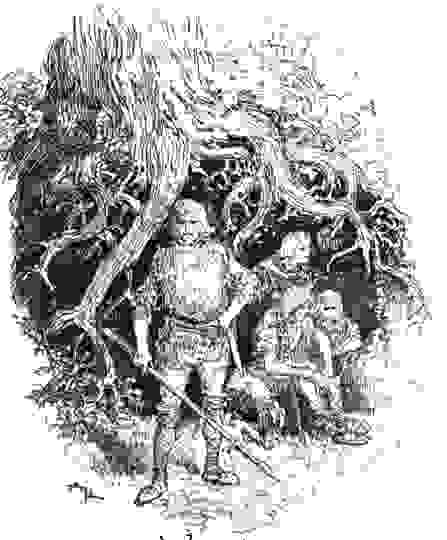
Renaud's little troop stayed a long time in the Ardennes forests, with little food and having to brave the snow and the cold.
So people start to die one after the other, so that in the end, only the 4 brothers and 4 horses are left.
But they look poor: hairy as beasts and rusty weapons.
Sad about this state and not knowing what to do in this misery, they return to Dordonne, where they were born.
There, they receive clothing and gold from their mother, engage an army and set off south with their cousin Maugis.
They arrive in Bordeaux where they help Yon, the king of Biscay, to beat the Saracens.
Yon lodges them for a while.

One day when the Aymon sons were hunting in the forest near the Gironde, they saw a very high mountain and asked King Yon to give them this place to build a fortress.
Once the castle is built, Yon asks Renaud what he intends to call it.
Renaud lets the king choose and, as the place is very beautiful and very nice, he suggests calling it Montauban (etymologically: "mont blanc", in the sense of "immaculate").
The fortress is soon inhabited by a very large number of people.
Advised by his barons and to be sure that Renaud would never get angry with him, King Yon gave him his younger sister Claire for wife.
By this marriage, King Yon is assured of Renaud's protection, which Renaud assures him of his best.
With Claire, Renaud will have two children: Yonet and Aymonet.
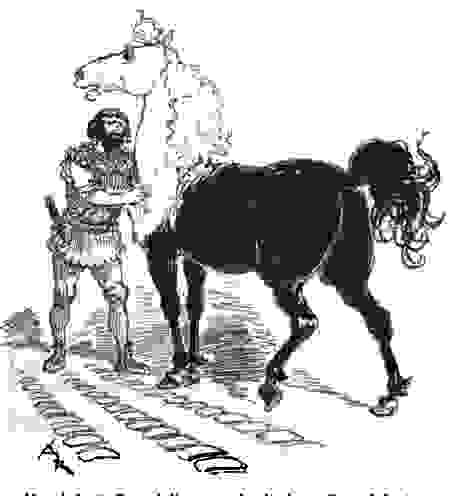
One day Charlemagne came up with the idea of going on a pilgrimage to Saint-Jacques-en-Galice.
On his return trip to Paris, he crosses the Gironde and sees the castle of Montauban.
Upon learning that it is the castle of his enemies, he demands that King Yon deliver them to him, threatening to destroy everything if he does not do so.
But Yon refuses. Charlemagne returns to Paris very annoyed.
There he meets Roland, his nephew and knighted him.
He wants to offer him the best horse in the kingdom and obviously thinks of Bayard.
He is therefore organizing a horse race which will take place in Paris on Midsummer Day, with a nice prize and the royal crown as a key.
Learning this in Montauban, Renaud wants to challenge the king with his horse and decides to participate in this race.
Accompanied by his brothers, Maugis and his people, he goes through Orléans, then Melun and arrives in Paris.
So, so as not to be recognized, Maugis rubs Bayard with a certain grass and the horse turns white, then he rubs Renaud with an ointment and he seems to be 15 years old.
This is how Renaud and Bayard, without being recognized, win the race.
Charlemagne was unable to pursue them and the brothers returned to Montauban with the king's crown.

Then follow a thousand adventures, bloody battles, twists and turns, pardons, sufferings, ...
Renaud even goes to Jerusalem where he finds Maugis and, together, they fight against the Persians.
He ends up returning to Montauban, to find his sons, whom he made consecrate knights by Charlemagne.
As for him, he withdraws from the castle and goes towards Cologne where he is assassinated by masons laborers.
Bayard is delivered to Charlemagne who throws him into the Meuse, in Liège, with a mill stone around his neck.
In the water, the horse hits the stone so hard that it can break free and it is said to be still alive in the Ardennes forest.
So, did the Four Aymon Sons come to Etalle?
If we believe the story printed in 1480, the castle of Montfort would rather be in the French Ardennes and Montauban would be on the side of Bordeaux, between Gironde and Dordogne.
But this is of course a legend and we must therefore let our imagination run wild and believe, for example, in this Bayard horse, which made no less than 30 feet (almost 10 meters) in a single stride.
Or again in this Renaud, "the most handsome man who was then in the world because he was 16 feet high (nearly 5 meters) at least".
We must also accept that Bayard has been everywhere to leave the imprint of his foot.
Etalle, in any case, is not the only town to claim the inspiration of the tale.
Montfort or Montessor, built on a rocky outcrop above the Meuse, is the name of the legendary castle of the four Aymon sons in the Ardennes.
Many locations are claimed, in Belgium as in France, to be or to have been Montessor.
Many "pas-Bayards" (Bayard steps) come from the imaginary passage of the fairy horse, which would have left the imprint of one of its hooves on the ground.
They are numerous in the Belgian Ardennes.
They exist in particular near Couillet (locality ô pa Bayâr), Pepinster, Aywaille (at the castle of Amblève, claimed for Montessor), Dolembreux, Remouchamps, Stoumont, Anthisnes or even Bra , Wéris, Ethe, Étalle, and in the forest of Chiny,
but also in Berthem, near Louvain or in Dortmund in Westphalia.
In Belgium, the best known of these toponyms is the Rocher Bayard, a stone obelisk some forty meters high, at the exit of Dinant towards Anseremme and on the banks of the Meuse.
The four Aymon sons would have been surrounded there by Charlemagne's soldiers.
Mounted on Bayard, they would have advanced on the point of the rocks to the rock named from Roche-à-Bayard (or the Bayard rock), and which, at that time still adhered to the neighboring mountain.
At the moment when the emperor believed to hold his enemies, Bayard struck the rock with his hoof and took off with a prodigious leap to fall again on the other side of the river.
On the now famous rock is still, it is said, the footprint of Bayard.
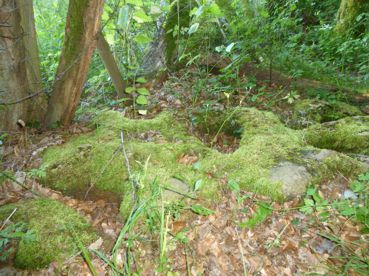 The one near the Bar farm is less spectacular: a mossy rock of barely 1 square meter at the foot of a tree. But it is true that it represents quite well the imprint of a horse's hoof ...
The one near the Bar farm is less spectacular: a mossy rock of barely 1 square meter at the foot of a tree. But it is true that it represents quite well the imprint of a horse's hoof ...
One of the most famous modern representations of the legend is The Bayard Horse, a sculpture made by Olivier Strebelle and initially shown to the public at the 1958 World's Fair.
It is placed along the Meuse in Namur, below the Ardennes bridge.
Another famous statue represents the Aymon sons in the company of Bayard.
Directed by Albert Poncin, it is in Bogny-sur-Meuse.
Many localities in France and Belgium have or have had a "Rue des Quatre fils Aymon", this is the case of Orleans, Brussels, Mons, Namur, Nevers or Marbache, in Meurthe-et- Moselle, etc.
In the district of Sedan, in the Ardennes, in the North of France, we find:
- the fortress of Château-Regnauld: a medieval fortress whose ruins are located on the upper course of the French Meuse near the village of Château-Regnault (municipality of Bogny-sur-Meuse) in the Ardennes department and whose the origins date back to the 12th and 16th centuries,
- in Létanne, the castle of Mont-Fort,
- a "Pas Bayard" (Bayard step),
- a dolmen called "the Table of Maugis",
- in the Bel-Air district, north of Charleville, a narrow valley known as the "Vallée aux Fées",
- from there, if we follow the direction that the 4 Aymon sons could have taken, we arrive at Château-Regnauld.
Is it the legend that gave the name to the place or is it the name of the place that inspired the legend?
Considering the many versions of the legend, it is obviously very difficult to know.
If we admit that the tale was created in the 11th or 12th century, it is then probable that our Montauban was not yet known by this name, since still in 1682, the forges of Montauban were called forge and furnace of Buzenol .
But it is quite likely that a later version of the chanson de geste was imagined in our region.
So let's be a little chauvinistic Gaumais ...
And as a small article from the local "Publi Vire" reported in June 2016:
- Renaud single-handedly embodies all the values of chivalry, courage, integrity, while Charlemagne, he is authoritarianism and treachery. And isn't like the Gaumais to refuse authority?
- The keep of Montauban / Buzenol, when it was excavated, was it not determined that it had burned down around the 7th-9th century, just when Charlemagne was emperor?
- And Allard, Guichard, Richard and Renaud, aren't these first names from Gaume?
- There is even an "Oak of the Four Sons Aymon" in Rulles.
-
And Ethe's "Pas Bayard" (Bayard step), it does not evoke the four brothers, but an episode experienced after their disappearance by the famous horse which had returned to the area after being thrown into the Meuse.
And so, Dinant and its rock, Termonde and its giants and others don't need to boast so much ...
Bibliography
- d'Albignac, J. Histoire des Quatre Fils Aymon, très nobles et très vaillants chevaliers. - 247p. - 1908 - ed. Maurice Bauche, Paris
- Publi Vire, Année patrimoniale 2016. 16e rencontre des Musées Gaumais : Croyances et Vie quotidienne. L'oeuvre de la semaine : duels de païens et de chrétiens ou la Légende des Quatre Fils Aymon. - Publi-Vire - Virton - n°22 - 8 juin 2016 - p.12